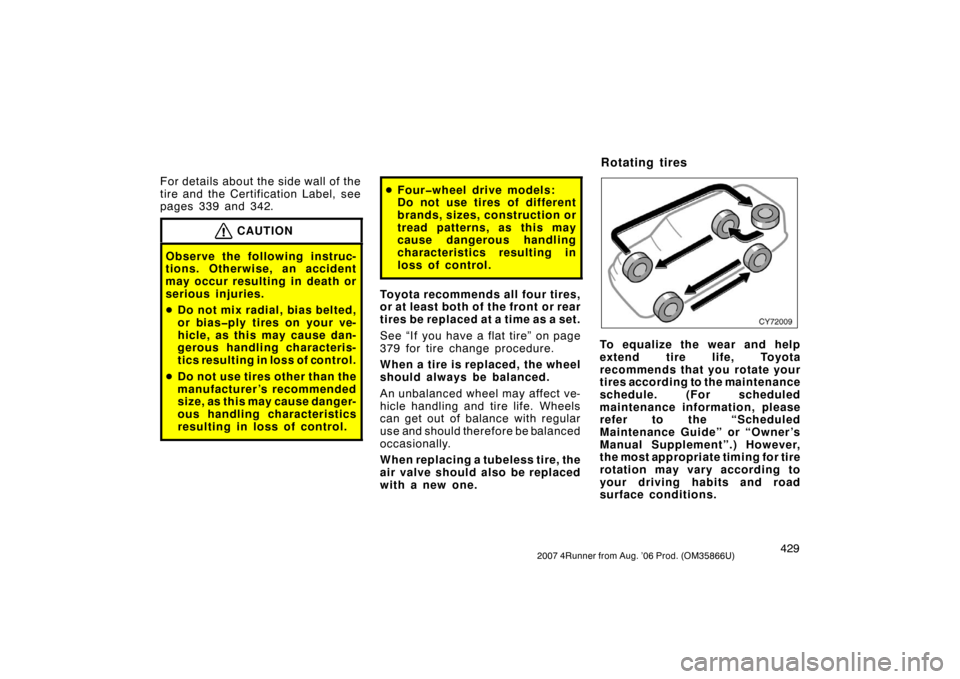Page 419 of 470

4092007 4Runner from Aug. ’06 Prod. (OM35866U)
Doors and engine hood
Check that all doors including back door
operate smoothly and all latches lock se-
curely. Make sure the engine hood sec-
ondary latch secures the hood from open-
ing when the primary latch is released.
Tire inflation pressure
Check the pressure with a gauge ev-
ery two weeks, or at least once a
month. See page 425 in Section 7−2
for additional information.
Tire surface and wheel nuts
Check the tires carefully for cuts,
damage or excessive wear. See page
427 in Section 7− 2 for additional in-
formation. When checking the tires,
make sure no nuts are missing, and
check the nuts for looseness. Tighten
them if necessary.
Tire rotation
Rotate the tires according to the
maintenance schedule. (For
scheduled maintenance information,
please refer to the “Scheduled
Maintenance Guide” or “Owner ’s
Manual Supplement”.) See page 429
in Section 7 −2 for additional
information.
Be on the alert for changes in perfor-
mance, sounds, and visual tip −offs that
indicate service is needed. Some impor-
tant clues are as follows:
�Engine missing, stumbling, or pinging
�Appreciable loss of power
�Strange engine noises
�A leak under the vehicle (however, wa-
ter dripping from the air conditioning
after use is normal.)
�Change in exhaust sound (This may
indicate a dangerous carbon monoxide
leak. Drive with the windows open and
have the exhaust system checked im-
mediately.)
�Flat −looking tire; excessive tire squeal
when cornering; uneven tire wear
�Vehicle pulls to one side when driving
straight on a level road
�Strange noises related to suspension
movement
�Loss of brake effectiveness; spongy
feeling brake pedal; pedal almost
touches floor; vehicle pulls to one side
when braking
�Engine coolant temperature continually
higher than normal If you notice any of these clues, take your
vehicle to your Toyota dealer as soon as
possible. It probably needs adjustment or
repair.
CAUTION
Do not continue driving with the ve-
hicle unchecked. It could result in se-
rious vehicle damage and possibly
personal injury.
Does your vehicle need
repairing?
Page 439 of 470

4292007 4Runner from Aug. ’06 Prod. (OM35866U)
For details about the side wall of the
tire and the Certification Label, see
pages 339 and 342.
CAUTION
Observe the following instruc-
tions. Otherwise, an accident
may occur resulting in death or
serious injuries.
�Do not mix radial, bias belted,
or bias�ply tires on your ve-
hicle, as this may cause dan-
gerous handling characteris-
tics resulting in loss of control.
� Do not use tires other than the
manufacturer’s recommended
size, as this may cause danger-
ous handling characteristics
resulting in loss of control.
�Four�wheel drive models:
Do not use tires of different
brands, sizes, construction or
tread patterns, as this may
cause dangerous handling
characteristics resulting in
loss of control.
Toyota recommends all four tires,
or at least both of the front or rear
tires be replaced at a time as a set.
See “If you have a flat tire” on page
379 for tire change procedure.
When a tire is replaced, the wheel
should always be balanced.
An unbalanced wheel may affect ve-
hicle handling and tire life. Wheels
can get out of balance with regular
use and should therefore be balanced
occasionally.
When replacing a tubeless tire, the
air valve should also be repl aced
w i t h a new on e.
CY72009
To equalize the wear and help
extend tire life, Toyota
recommends that you rotate your
tires according to the maintenance
schedule. (For scheduled
maintenance information, please
refer to the “Scheduled
Maintenance Guide” or “Owner’s
Manual Supplement”.) How ever,
the most appropriate timing for tire
rotation may vary according to
your driving habits and road
surface conditions.
Rotating tires
Page 459 of 470

4492007 4Runner from Aug. ’06 Prod. (OM35866U)
AUTOMATIC TRANSMISSION
Fluid capacity (drain and refill),
L (qt., Imp. qt.):Up to 3.0 (3.2, 2.6)
Fluid type: Toyota Genuine ATF WS
Change automatic transmission fluid only
as necessary.
Generally, it is necessary to change
automatic transmission fluid only if your
vehicle is driven under one of the Special
Operating Conditions listed in your
“Scheduled Maintenance Guide” or
“Owner ’s Manual Supplement”. When
changing the automatic transmission fluid,
use only “Toyota Genuine ATF WS” (ATF
JWS3324 or NWS9638) to aid in assuring
optimum transmission performance.
Notice: Using automatic transmission
fluid other than “Toyota Genuine ATF
WS” may cause deterioration in shift
quality, locking up of your transmission
accompanied by vibration, and ultimate-
ly damage the automatic transmission
of your vehicle.
Please contact your Toyota dealer for fur-
ther details. TRANSFER
Oil capacity, L (qt., Imp. qt.):
1.4 (1.5, 1.2)
Oil type: Hypoid gear oil API GL −5
Recommended oil viscosity: SAE 75W −90
DIFFERENTIAL (4.0 L V6 [1GR�FE] en-
gine)
Oil capacity, L (qt., Imp. qt.): Tw o −wheel drive models
3.05 (3.2, 2.7)
Four −wheel drive models
Front 1.5 (1.6, 1.3)
Rear 3.05 (3.2, 2.7)
Oil type: Hypoid gear oil API GL −5
Recommended oil viscosity: Front
SAE 75W −90
Rear Above −18 �C (0 �F)
SAE 90
Below −18 �C (0 �F)
SAE 80W or 80W −90 DIFFERENTIAL (4.7 L V8 [2UZ�FE] en-
gine)
Oil capacity, L (qt., Imp. qt.):
Tw o −wheel drive models
3.05 (3.2, 2.7)
Four −wheel drive models
Front 1.4 (1.5, 1.2)
Rear 3.05 (3.2, 2.7)
Oil type: Hypoid gear oil API GL −5
Recommended oil viscosity: Above −18 �C (0 �F)
SAE 90
Below −18 �C (
0 �F)
SAE 80W or 80W −90
CHASSIS LUBRICATION
Propeller shafts: SpidersLithium base chassis grease, NLGI
No.2
Slide yokes Molybdenum −disulfide lithium base
chassis grease, NLGI No.2 or lithium
base multipurpose grease, NLGI No.2